Countless factors impact the success of a product, including market research, user experience, and marketing, to name a few.
But when you zoom out and look at the big picture, product team structure is one of the most influential factors as it affects virtually every element of product success.
In this post, we’ll examine the different types of product team structures, specific roles within the product team, and more.
That way you’ll know which product organizational structure is best for your business and how individual teams fit in with the grand scheme of things.
5 Common Product Team Structures
1. Product or Individual Product Feature Structure
Let us first state that this type of product team structure is usually not right for small businesses that have just one product with simple, straightforward features.
It’s designed for those with A) multiple products or B) a product with a wide array of complex features.
In the SaaS industry, HubSpot would be a great example of this, as they have a robust product suite.
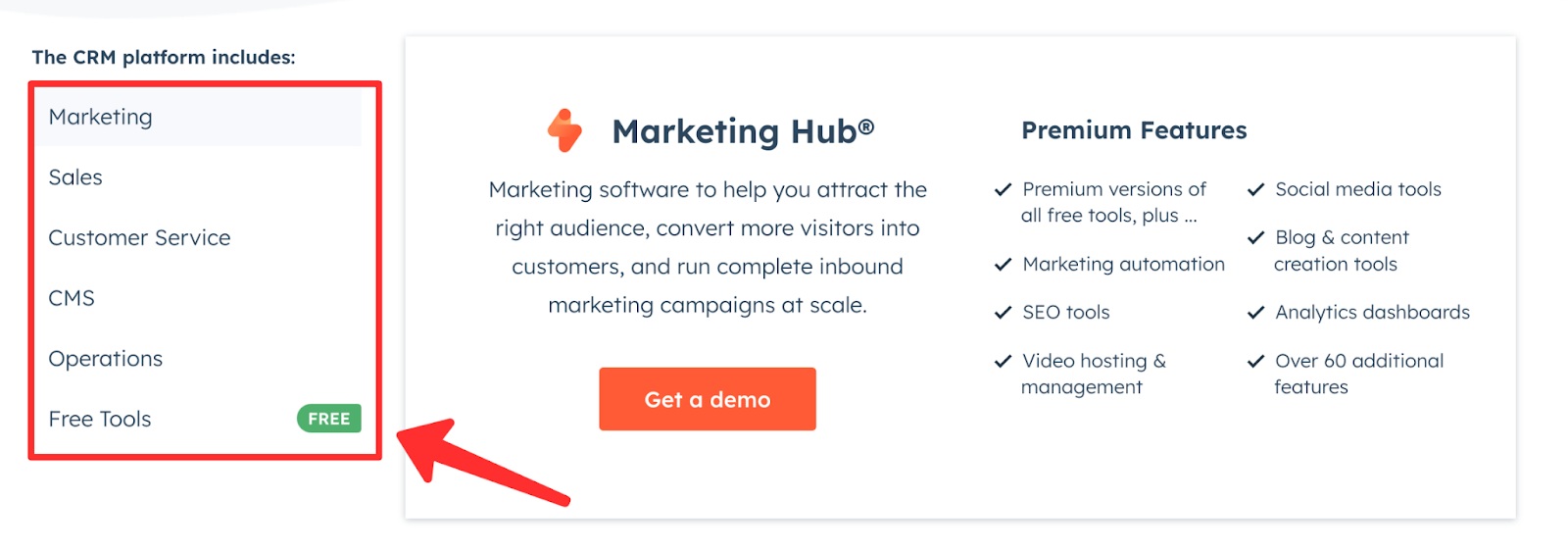 Source: HubSpot
Source: HubSpot
Rather than having a single team to try and handle everything, which can be inefficient and time-consuming, structuring your team by product or individual product feature is often the better way to go.
By dedicating a team to each while operating under a unified product manager, you can ensure you’ve got adequate manpower and maintain a clear organization with product management.
So whether you have an entire suite of products, a product with comprehensive features, or both, everyone involved works together cohesively.
In turn, this gives you a greater chance of achieving product success than if you spread yourself thin by assigning a single product person to handle everything themself.
But again, to justify this product development team structure, you need to have a sizable number of products and/or product features.
2. Customer Persona or Customer Segment Structure
This type of product organization structure is based on tailoring your product(s) to match the unique needs of different types of customers.
Suppose you place a large emphasis on appealing to multiple customer personas/segments. In that case, this is likely a good functional structure for you, as it enables you to focus on creating a highly personalized customer experience.
 Source: CultureHive
Source: CultureHive
With this type of product management, you assign a specific team to each persona/segment, along with a dedicated product manager to oversee everything.
From there, a product manager communicates with other product management leaders to ensure everyone is on the same page at all times.
Given that 80% of customers prefer to do business with a company that provides a personalized experience, and 80% of companies that use segmentation see increased sales, it’s easy to see why this is one of the more popular product team structures.
In terms of the number of segmentation criteria, today’s average company has 3.5 different segments.
So if your business also has around three or four different segments, you would focus on understanding the needs of each and then developing and refining your product(s) to meet customer needs and provide the best customer experience possible.
This would translate into three or four project management teams for each segment, along with a dedicated team manager.
3. Cross-Functional Collaboration Structure
Like a product or individual product feature structure, this is usually intended for large teams that are continually (and rapidly) scaling.
Say, for instance, you’re at a place in your business growth where you’re consistently rolling out new product features and need to efficiently get them to your customers.
With a cross-functional collaboration structure, you would break your product team down into smaller groups where each group essentially operates autonomously.
In turn, they’re able to efficiently release new features without having to get every little detail greenlit by a project manager.
Take team communication and productivity app, Slack, for example. They’re constantly rolling out new features.
 Source: Slack
Source: Slack
Using a cross-functional collaboration structure would put them in a position to streamline the process without being tethered by having to continually get approvals, thus quickly bringing new features to market.
Again, this isn’t the best organizational structure for everyone. If you’re a small business and only occasionally roll out a few new features here and there, it’s probably not optimal.
But if rapid new feature development is a core focus of your product development team and needing constant approvals is a hindrance to product management, it certainly can be.
4. Customer Journey Stage Structure
The modern customer journey is more complex than ever, often spanning several different touchpoints along the way.
Here’s an illustration of how someone may navigate their way through the customer journey.
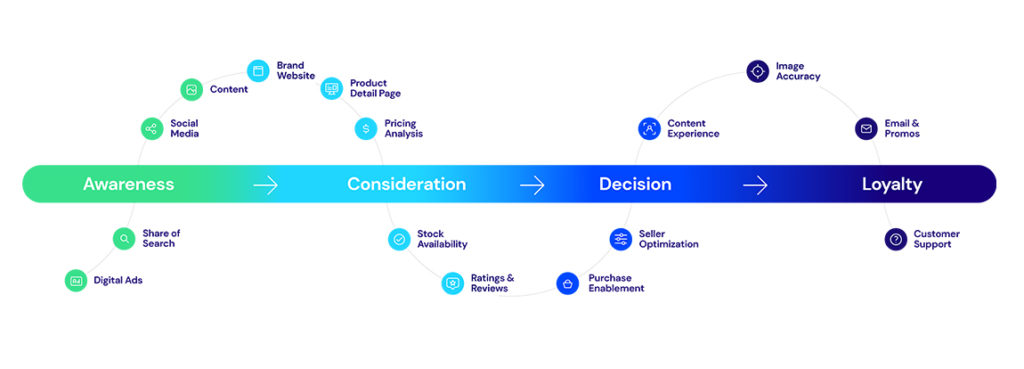 Source: Pricespider
Source: Pricespider
One way to better accommodate customer needs and make the process as smooth as possible is by using a customer journey stage structure.
As its name implies, this involves dedicating a product manager to each stage of the customer journey to ensure everything is seamless and there are no major points of friction along the way.
For instance, you may assign one product manager to enhance the product page, pricing analysis, and other elements of the consideration stage.
 Source: Pricespider
Source: Pricespider
And may assign a different product manager to handle everything post-purchase, such as customer support, future promotions, and so on.
 Source: Pricespider
Source: Pricespider
Each product manager will have a corresponding team under them, and they will communicate with other product management leaders to ensure each stage in the customer journey is fully optimized.
The specifics will vary, but using a customer journey stage structure can work well if optimizing end-to-end touchpoints in the customer journey is a top priority for your company.
5. Performance Metrics Structure
Almost every product management team has particular KPIs they focus on to measure success.
Some examples can include new leads, monthly sales growth, conversion rate, and overall revenue.
 Source: Aptivo
Source: Aptivo
Basing your product team structure around performance metrics is where you assign a team to specifically work on optimizing and improving your core KPIs.
Say, for instance, the main KPI you wanted to concentrate on was getting the maximum percentage of people who signed up for a free trial to upgrade to the paid version of your product.
You could have a dedicated team that’s solely dedicated to that KPI who reports to a designated product manager.
 Woopra analytics dashboard
Woopra analytics dashboard
By using this organizational structure, it puts your company in a better position to 1) accurately measure your core KPIs and 2) achieve the improvements you need.
Over time, this can have a significant impact on the overall success of your product and prevent unnecessary hiccups in the customer journey.
Core Roles Within the Product Team
Product Development
Simply put, the people on a product development team oversee the entire process end-to-end.
From the initial conception of a product to market research to design and prototyping to the eventual market release, they’re involved every step of the way.
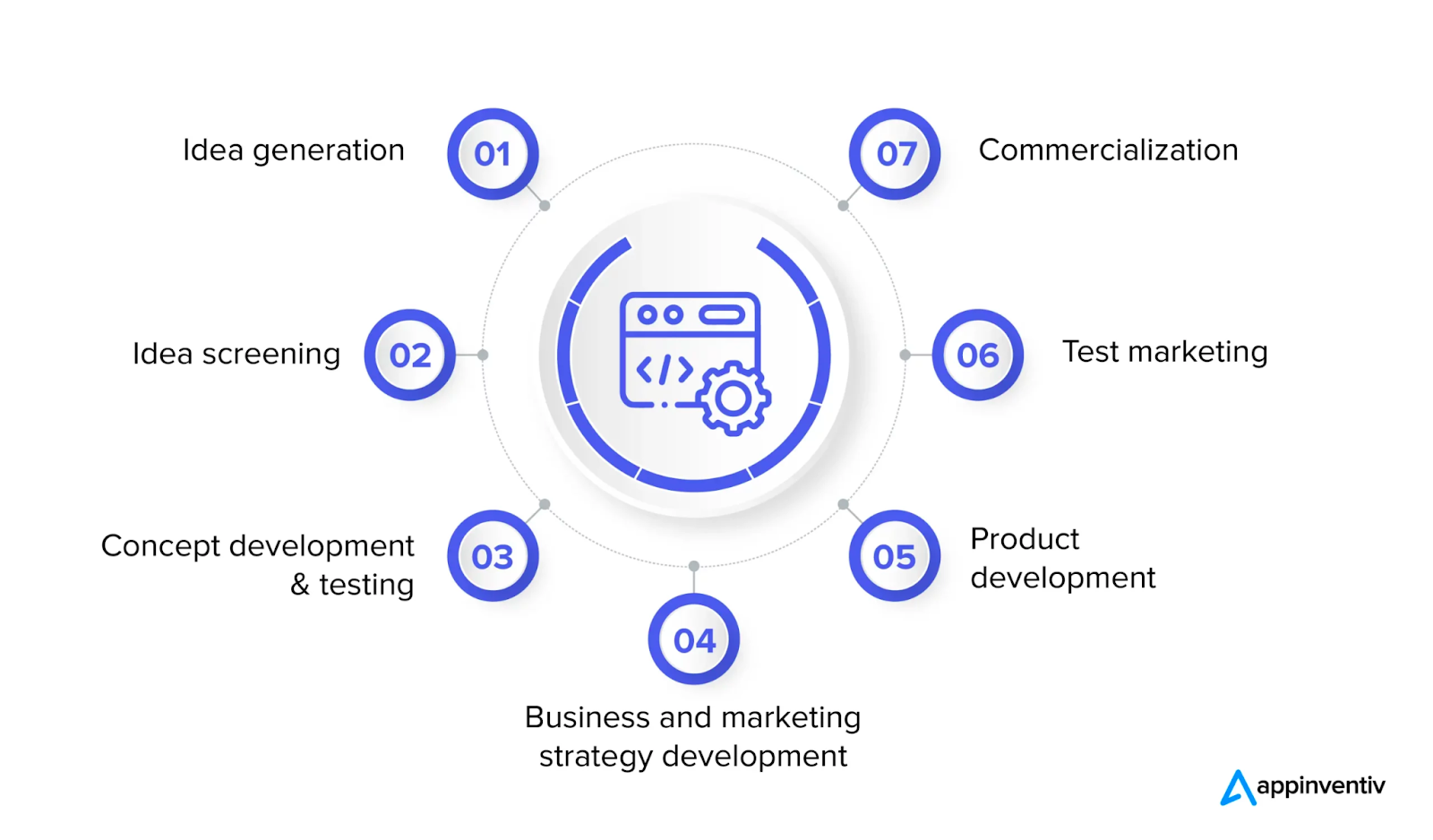 Source: Appinventiv
Source: Appinventiv
As Aha! roadmap software explains, “Besides choosing what to build, they communicate the benefits and measure the performance of the product — crucial duties within any company. The ultimate goal is to deliver value to customers and support the business.”
While the exact size of a product development team will vary, there can be a wide variety of people involved, including a product designer, software developers, engineers, quality assurance testers, and product managers.
Their main goal is to work together collaboratively to come up with a high-quality product that solves a customer problem and execute the series of steps needed to bring that product to market.
Because of the wide variety of roles and the number of steps involved in product development, it’s critical to have strong product leaders and team members work together efficiently.
User Experience and Design
This role is pretty self-explanatory.
It’s the user experience (UX) and design team’s responsibility to ensure that a product does its job and is satisfying for the product owner.
To accomplish this, a product line must meet seven key criteria. It must be:
- Desirable
- Delightful
- Useful
- Learnable
- Memorable
- Effective
- Efficient
 Source: Focus7
Source: Focus7
Whether it’s a physical product, software, a website, or an application, the UX and design team’s job is always the same.
There’s a lot that goes into this role, but some of the key tasks include:
- Prototyping to visualize the product’s design, layout, and functionality
- User interface design to optimize overall aesthetics and make the product user-friendly
- Usability testing to assess overall usability and specific issues that need to be addressed
- User testing to gather feedback through product analytics, user surveys, and so on to refine product design and identify potential areas for improvement
Given that UX trends are continually evolving and competitors are bringing new products to market, UX professionals must stay up-to-date and be proactive about making changes to provide the best possible experience for the product owner.
For example, a UX product manager may stay current on trends by reading product analytics books to stay current on what’s happening.
Also, this is a highly collaborative area of product development that involves frequent communication between the UX manager, key stakeholders, and other product management teams.
Project Management
Let us start by saying the exact responsibilities of a project management team, or in some cases, a single project manager, can vary significantly.
But common responsibilities found across the board include the following:
- Initial project planning and product management strategy to define core goals and deliverables
- Budget requirements and where to allocate resources
- Product development timeline creation and scheduling to ensure a project stays on track
- Budget management to ensure expenses don’t exceed what they should
- Quality assurance
- Issue resolution
- Reporting
- Ongoing product iterations for continuous improvements (agile team structure is a popular choice to accommodate those iterations)
While most roles within a product team are communication-intensive, project management is perhaps the most reliant of all upon communication.
Those involved must not only communicate with multiple teams from conception to completion and beyond, but also with the chief product officer, business analyst, key stakeholders, sales team, clients, and end-users.
Here’s an illustration to help visualize the role of project management in a product team and how they navigate throughout each step in the product development cycle.
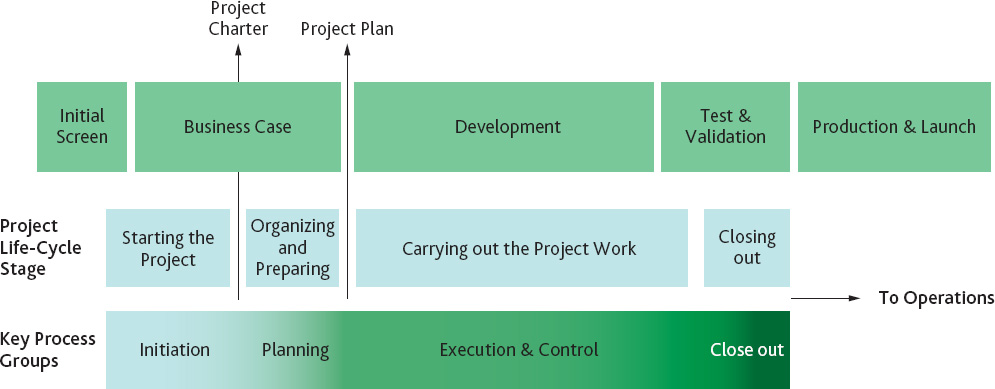 Source: Project Management Institute
Product Marketing
Source: Project Management Institute
Product Marketing
Product Marketing
A product marketing team has three main goals:
- Understand who a company’s target audience is
- Develop effective marketing strategies to reach that audience and maximize engagement
- Create demand for a product
The way a product marketing growth team goes about achieving its goals can vary from company to company, but here are some common responsibilities.
- Creating customer personas to fully understand who they’re trying to reach, customer segments, and specific customer needs
- Developing a unique value proposition (UVP) to differentiate a product and articulate why a potential customer should choose that product over a competitor’s
- Developing brand messaging to effectively convey things like UVP and product features
- Creating lead generation strategies
- Choosing which specific marketing channels to use to most efficiently reach a target audience and maximize ROI
- Generating content such as blog posts, videos, case studies, social media posts, and so on
- Analyzing marketing data to determine which strategies are working, which need to be refined, and which to scrap
- Communicating analytics findings to other product teams to guide decisions on product updates, new features, and expansions (something usually done by a product analytics manager)
As CXL puts it, “product marketing is in the middle of just about everything,” and plays an incredibly important role in the long-term success of a product.
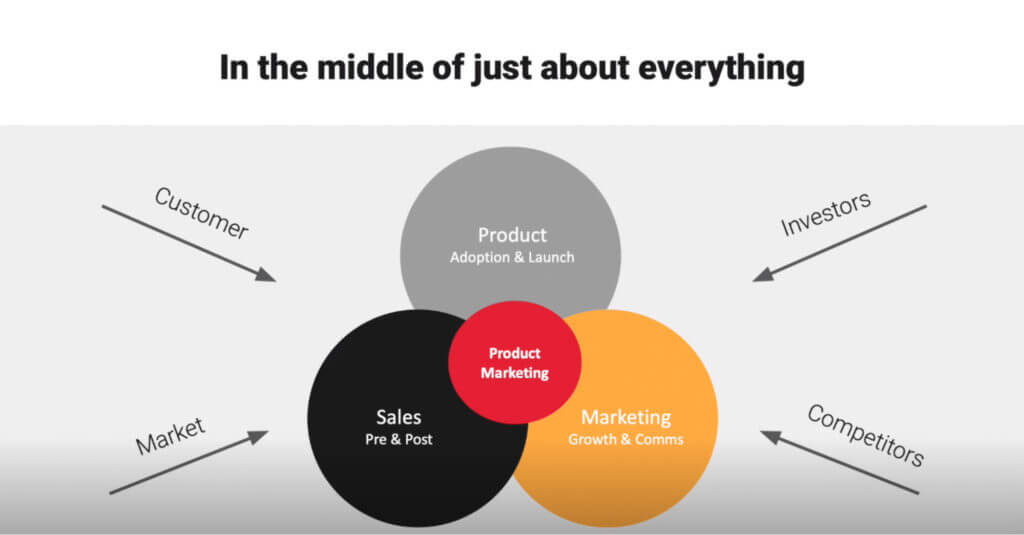 Source: CXL
Source: CXL
After all, even the greatest product will likely fall short if it lacks sound product marketer leadership — something that starts with a team of product marketing professionals.
Engineering
While roles within the team like product development and UX focus on product specifications, an engineering team is the group of people that bring it to fruition.
For something physical, this means actually building it and turning it into a manufacturable product.
Or in the case of a digital product, this means building the technical architecture, including software development and subsequently, testing and having a platform team debug the code until it’s just right and aligns with your overall product vision.
Because other roles within a product organization team structure essentially hand off what they’ve discovered and planned to the engineering team, there needs to be a high level of communication every step of the way.
Otherwise, it’s difficult to satisfy the product owner and achieve true customer success.
For example, if a specific feature is critical to ensuring a positive UX, there must be tight collaboration between the UX designer and engineering team to ensure the latter thoroughly understands the specifications so they can properly execute.
Besides building the initial version of a product (version 1.0 if you will), ongoing quality assurance, feedback after product ownership, and performance optimization are all critical to engineering.
How the Product Team Works with the Rest of the Organization
In many ways, a product team is the linchpin that serves as a bridge between several different areas of an organization.
From the very top where they communicate with executive-level stakeholders that oversee an organization to customer support teams that gather feedback to facilitate product refinement and everywhere in between, a product team works closely with nearly everyone involved.
When it comes to company leaders, for instance, a product team will work alongside them to determine the product vision, mission, and specific objectives to guide every subsequent step.
When collaborating with customer support, this means identifying particular pain points to swiftly make product feature improvements and enhance the overall customer experience.
And that’s just the tip of the iceberg.
A product team may also communicate with a finance department to properly allocate resources and manage product development investments.
They may communicate with human resources to assist in the efficient onboarding of each new team member.
They may even communicate with a legal team to ensure a product is compliant with relevant laws and regulations.
So, as you can see, having a cross functional team like this makes sense given the product itself is the lifeblood of a company.
As we mentioned earlier, multiple factors contribute to a business’s success. But the quality (or lack thereof) of a product is absolutely critical. And this largely hinges on product management and how well a team interacts with the rest of an organization.
Wrapping Up
A product team organizational structure is complex and ever-evolving, with multiple moving parts.
To succeed, each part must be in sync with every other part and stay in a continuous communication loop. To clarify which characteristics contribute to a successful product team, some of the most essential include being highly collaborative, maintaining transparency, aligning with organizational goals, striving toward making continual improvements, and always optimizing the end-user experience.
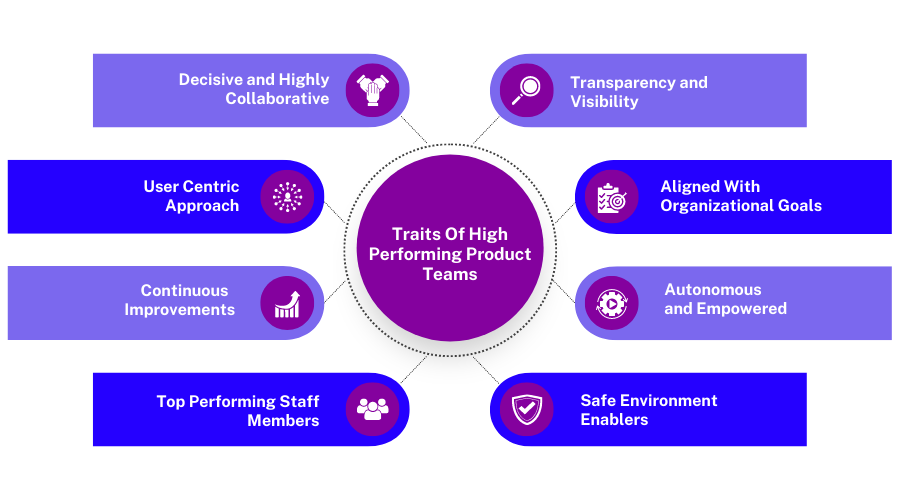 Source: Chisel Labs
Source: Chisel Labs
Deciding the exact approach to take when structuring your product management team can, admittedly, be a tough task. Further, it isn’t a one-off type of deal and will require perpetual adjustments.
But by crystallizing your product vision and the specific goals you want to achieve with your product roadmap, it should lay the groundwork for developing an effective team structure that gets you where you need to go.



